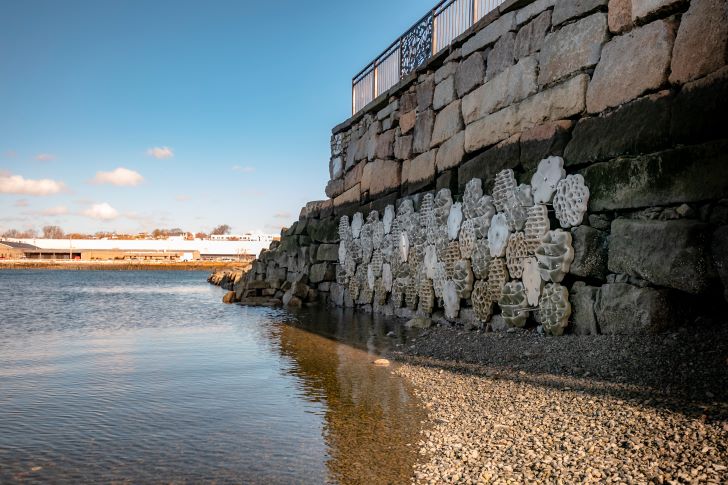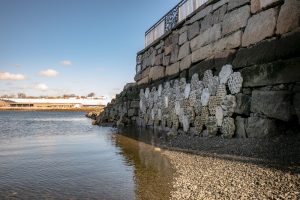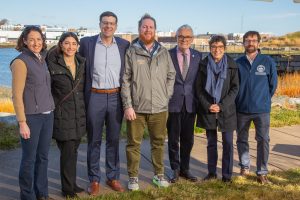North America’s first-ever Living Seawalls habitat panels installed by Stone Living Lab at two Boston Harbor sites


 The Stone Living Lab’s Living Seawalls project at Condor Street Urban
The Stone Living Lab’s Living Seawalls project at Condor Street Urban
Wild in East Boston (Photo Credit: Christian Merfeld, Boston Harbor Now)
Media contacts: Peter Howe/Katherine Adam, Denterlein, for Stone Living Lab
phowe@denterlein.com
kadam@denterlein.com
press@stonelivinglab.org
617-482-0042
FOR IMMEDIATE RELEASE
BOSTON, Mass., November 22, 2024 – North America’s first-ever “Living Seawalls” panels were installed by the Stone Living Lab at two locations on Boston Harbor this month. The panels are specially designed to create habitat for marine life to flourish on what would otherwise be inhospitable flood barriers.
The Condor Street Urban Wild in East Boston and Fan Pier in the South Boston Waterfront neighborhood are now home to 240 Living Seawalls panels, which mimic beneficial natural habitats like rock pools. The project is exploring how Living Seawalls panels can help increase biodiversity and abundance of ocean life, improve water quality, and potentially soften wave impact while also mitigating the environmental downsides of existing seawalls.
The Stone Living Lab is a Boston-based research partnership led by Boston Harbor Now and the University of Massachusetts Boston, along with City, State, Federal, and Indigenous partners.
The Living Seawalls project is a collaboration between the Stone Living Lab and Living Seawalls. Living Seawalls is a flagship program of Australia’s Sydney Institute of Marine Science, and was a finalist for the 2021 Earthshot Prize, an annual award launched by Prince William and Princess Catherine, the Prince and Princess of Wales, to search for and scale up the most innovative solutions to the world’s greatest environmental challenges.
In 2022, when the Earthshot Prize was held in Boston, the Stone Living Lab was introduced to the Living Seawalls team. Since then, the two organizations and their collaborators have conducted project planning, site selection, baseline research and monitoring, panel design, panel fabrication, permitting, educational program planning, and installation.
Stone Living Lab researchers will now perform monthly surveys of the panels and nearby control sites (areas with no panels) to observe and record the population of ocean-dwelling plants and animals over time and conduct other scientific research on the benefits and impacts of the project.
In addition to the Stone Living Lab and Living Seawalls, other project collaborators include Woods Hole Group, SumCo Eco-Contracting, the City of Boston, Boston Children’s Museum, the JFK Library Foundation, Museum of Science, The Fallon Company, and CBRE. The project is supported by the James M. and Cathleen D. Stone Foundation, 11th Hour Racing, the Commonwealth of Massachusetts, and the Cabot Corporation Foundation.
 Speakers at the Stone Living Lab’s media tour on November 22 (left to right): Undersecretary Antos, Councilor Coletta Zapata, Representative Madaro, Joe Christo, Chancellor Suárez-Orozco, Kathy Abbott, and Chris Osgood (Photo Credit: Dominique Sindayiganza)
Speakers at the Stone Living Lab’s media tour on November 22 (left to right): Undersecretary Antos, Councilor Coletta Zapata, Representative Madaro, Joe Christo, Chancellor Suárez-Orozco, Kathy Abbott, and Chris Osgood (Photo Credit: Dominique Sindayiganza)
Representatives from the Stone Living Lab and its collaborators gathered on Friday, November 22, 2024 at Condor Street Urban Wild in East Boston for an official launch of the project and unveiling of the new Living Seawalls installations.
“Boston is proud to host North America’s first-ever Living Seawalls, a groundbreaking step forward in integrating innovation with nature to protect our coastline and enhance biodiversity,” said Boston Mayor Michelle Wu. “As we confront the challenges of climate change, projects like this demonstrate how we can reimagine our urban waterfronts—not just as barriers against the rising seas but as vibrant ecosystems that benefit our communities and marine life alike. We’re grateful to the Stone Living Lab, Boston Harbor Now, UMass Boston, the Earthshot Prize, and all our partners for making this milestone a reality and for continuing to lead the way in climate resilience.”
“In many of our urban areas, we rely on seawalls to protect our communities. Living Seawalls are an innovative solution to incorporate elements of natural ecosystems into gray infrastructure,” said Massachusetts Energy and Environmental Affairs Secretary Rebecca Tepper. “This project demonstrates the importance of our partnership with the Stone Living Lab to pilot and evaluate the incredible potential of nature-based strategies and identify strategies to increase the resilience of our coastal communities.”
“As we look to the future of the Harborwalk, we must ‘green’ our gray infrastructure to make our waterfront more welcoming and alive,” said Boston Harbor Now President and CEO Kathy Abbott. “We are proud to help bring Living Seawalls to North America, and to catalyze collaboration around financing and facilitating more innovative coastal projects with our communities.”
“The installation of Living Seawalls panels in Boston marks a historic step in pioneering climate resilience solutions for the city,” said UMass Boston Chancellor Marcelo Suárez-Orozco. “Indeed, the prospect of restoring marine habitat and nurturing biodiversity in Boston Harbor is both a real-time example of how innovative, imaginative research can move the world forward, and a profoundly important win in the one battle we cannot afford to lose.”
“We are so excited to be exploring the benefits that Living Seawalls can provide for urban waterfronts as we face the challenges related to climate change and sea-level rise,” said Joe Christo, Managing Director of the Stone Living Lab and the Chief Resilience Officer at Boston Harbor Now. “Innovative projects like this do not happen without close partnership, and we are so thankful to have many great partners on this project. We look forward to collecting real-world field observations, and collaboratively learning how Living Seawalls can complement other nature-based approaches for coastal resilience in Boston and other urban waterfronts throughout the region and country.”
“By studying how Living Seawalls can enhance biodiversity by providing many of the features found on New England’s iconic rocky shores, we’re excited to see if we can turn seawalls into a win-win scenario for humans and nature,” said Jarrett Byrnes, a UMass Boston Marine Biologist and Stone Living Lab Researcher who leads research for the project. “Even in the first few weeks, we are already seeing our snails, mussels, algae, and more begin to colonize our Living Seawalls. We are excited to see how these Living Seawalls grow and change in the coming years into robust beautiful rocky intertidal communities.”
“Living Seawalls is incredibly excited to partner with the Stone Living Lab and bring marine life to built structures in Boston Harbour. This is an amazing opportunity to create a lasting legacy of the Earthshot Prize and hopefully raise awareness that this approach could be applied for ecological benefits across North America,” said Katie Dafforn, Co-Founder, Living Seawalls and Associate Professor, Macquarie University.
“The Living Seawalls project helps us understand how we can improve the health and habitat of our harbor as we invest in coastal resilient infrastructure,” said Chris Osgood, Director of the City of Boston’s Office of Climate Resilience. “I want to thank the Stone Living Lab and all the partners who made this project possible. Collaboration and innovation are hallmarks of this project and are essential in our climate resilience efforts.”
“The Living Seawalls project is an inspiring demonstration of how to create vital habitat while protecting our shorelines,” said Massachusetts Climate Chief Melissa Hoffer. “As sea levels rise and natural habitats are threatened, dynamic solutions that showcase the power of innovation and sustainability are essential to building resilient coastal communities.”
“For decades, East Boston shouldered an unfair burden of environmental pollution. Today, we celebrated a new living seawall in Eastie that is already welcoming marine life back home,” said Massachusetts Representative Adrian C. Madaro. “Through this initiative, we are recapturing land, bringing back native species, and fighting climate change and sea level rise with nature-based solutions.”
“I’m thrilled to see North America’s first Living Seawalls in East Boston, a community already impacted by coastal flooding and storm surges. These panels support marine life and boost biodiversity, offering innovative solutions for climate resilience. Boston is fortunate to have partners like the Stone Living Lab, Boston Harbor Now, and UMass Boston helping strengthen our waterfront,” said Boston City Councilor Gabriela Coletta Zapata.
“The Stone Living Lab has partnered with federal, state, and local government, and community groups, on the Living Seawalls project. This is exactly the type of dynamic collaboration we need to address the challenges of climate change,” said Massachusetts Representative Sean Garballey. “As the Chair of the Massachusetts House Committee on Global Warming and Climate Change, I am so excited to support this project, and look forward to seeing how the things we learn from it can benefit communities throughout the Commonwealth.”
“I am extraordinarily pleased that the Living Seawalls have been installed as part of UMass Boston’s efforts with the Stone Living Lab, Boston Harbor Now, and the Stone Foundation,” said Carol Thornber, Dean of UMass Boston’s School for the Environment. “As a marine environmental scientist, I can appreciate the enormous efforts by many partners to make this installation a reality. I look forward to the excellent information on climate resilience that these Living Seawalls will provide going forward.”
“All of us are facing the challenge of climate change, and most young children are eager to learn about what they can do to help. Stone Living Lab has taken steps to address this need by providing an excellent educational opportunity for all of us to experience, learn from, and enjoy – Living Seawalls. Boston Children’s Museum is proud to partner with the Lab on their innovative vision to ensure a greener world for generations to come, and we are excited to explore the many learning opportunities Living Seawalls will provide to our children and families!” said Carole Charnow, President & CEO of Boston Children’s Museum.
“The Stone Living Lab’s ability to bring together government, academia, and nonprofits to install Living Seawalls in Boston Harbor and evaluate their effectiveness in building resilience is a remarkable demonstration of collective impact and the potential of nature-based solutions. We are thrilled to showcase this groundbreaking work in our new Innovation: Earth exhibition and to amplify the Lab’s efforts across our educational platforms, sharing these advancements with our visitors at the pace of innovation,” said Tim Ritchie, President of the Museum of Science.
“The Living Seawalls project reflects the core principles of the Stone Living Lab – innovation, restoration, education, and climate resilience. In collaboration with multiple partners and a deep commitment to our waterfront and ecosystem, the Lab has launched this project, and we look forward to the research team sharing the lessons learned with climate leaders locally and globally,” said Sonja Plesset, Executive Director of the James M. and Cathleen D. Stone Foundation.
“Coastal communities are facing an uncertain future with the prospect of rising sea levels and increasing storms. This mounting pressure coupled with aging coastal infrastructure and negative impacts associated with some of the traditional gray engineering methods necessitates an expanded variety of solutions. The Living Seawalls project provides an enhancement to coastal protection by building resilience, fostering biodiversity, and maintaining the public connection to the sea. We look forward to evaluating the performance of these panels to learn not only about their ecosystem benefits, but also their ability to dissipate coastal energy” said Kirk Bosma, Senior Coastal Engineer and Vice President at Woods Hole Group, and Engineering Director at the Stone Living Lab.
-30-
Pictures of the Living Seawalls project, and some of the project’s leaders, can be found at the following link. Please reach out to Peter Howe or Katherine Adam at Denterlein for questions about captions. Please credit the Stone Living Lab and Dominique Sindayiganza.
https://drive.google.com/drive/folders/1PK1AvtlYDk9uSej1yOK_HLC9nl7hRx9c?usp=sharing
Contact Peter Howe or Katherine Adam at Denterlein to arrange an interview with one or more of the Stone Living Lab project representatives:
About the Stone Living Lab
The Stone Living Lab (SLL) is an innovative and collaborative initiative focused on testing and scaling up nature-based approaches to climate adaptation in Boston Harbor and beyond. We are a unique partnership between government agencies and nonprofits: Boston Harbor Now, UMass Boston School for the Environment, the City of Boston, the Massachusetts Department of Conservation and Recreation, the Massachusetts Executive Office of Energy & Environmental Affairs, the National Park Service, and the Massachusett Tribe at Ponkapoag. As a “Living Lab,” we bring research into the real world by engaging scientists and the community in collaborative design and exploration. Our work brings us not only along the coastline of Boston Harbor, but into the water itself and out among the Boston Harbor Islands and other locations. Our areas of focus are research and monitoring, education and engagement, policy innovation, and climate preparedness.
About Living Seawalls
Living Seawalls is a flagship program of the Sydney Institute of Marine Science. Its habitat panels, designed to mimic natural formations like rock pools and mangrove roots, can be fitted to new or existing sea defenses like seawalls or levees. The project is a collaboration between creative designers and marine ecologists. As a result, life has found its way back to the Sydney shorelines. Sea defenses fitted with habitat panels have 36% more marine life after just two years, with further increases expected through time. Up to 115 species of invertebrates and seaweed, as well as tens of species of fish thrive among the panels. The project operates at 11 Australian locations, and it has since gone global. It now benefits shorelines in Wales, Gibraltar, Singapore, the United Kingdom, and now the United States in Boston!